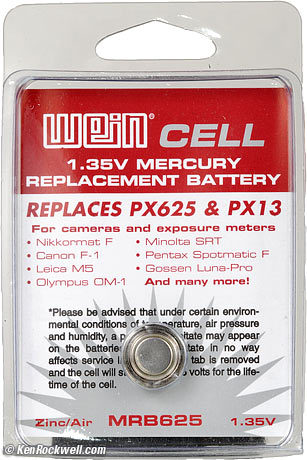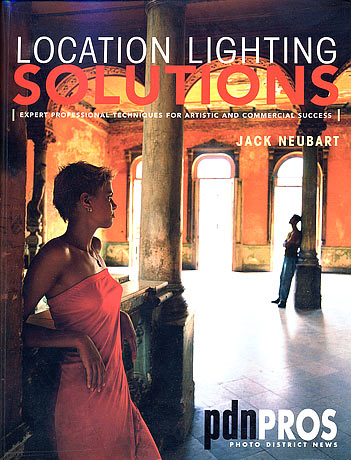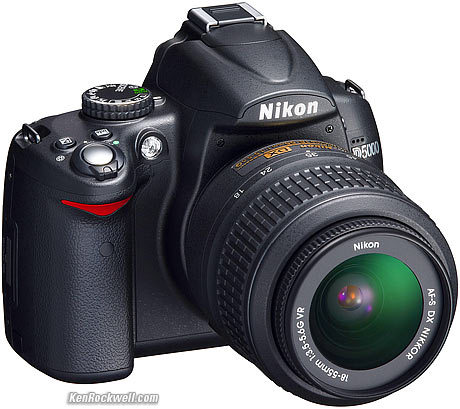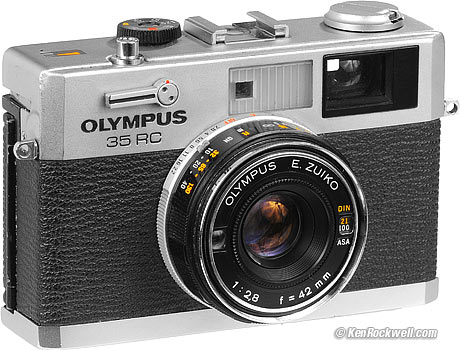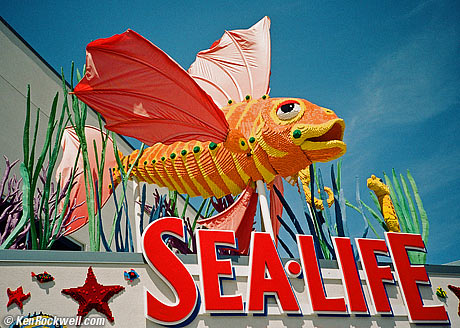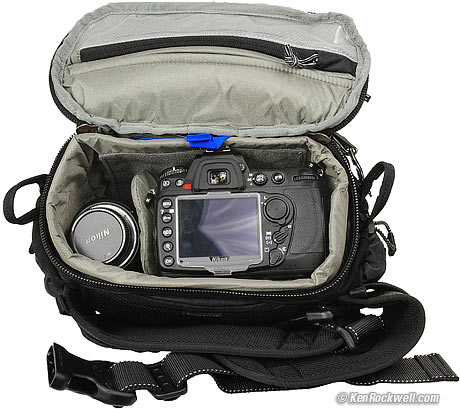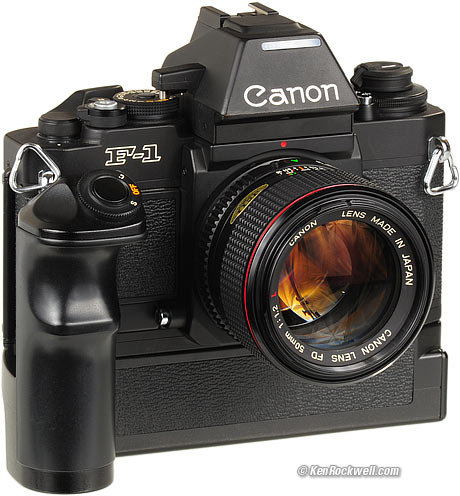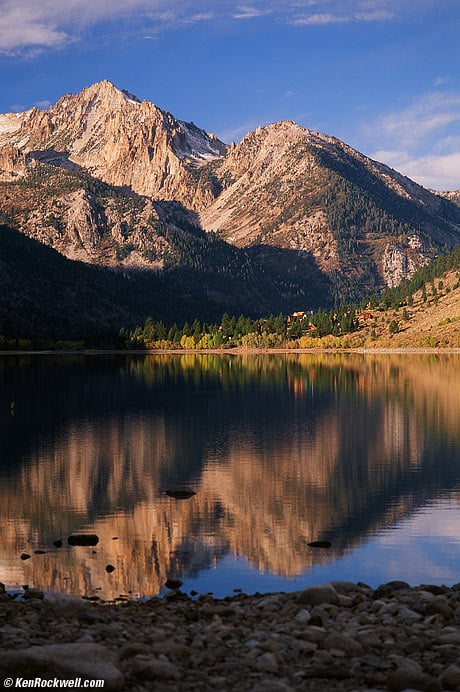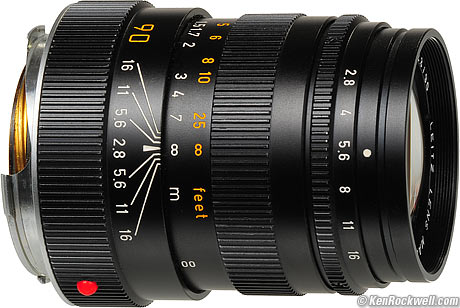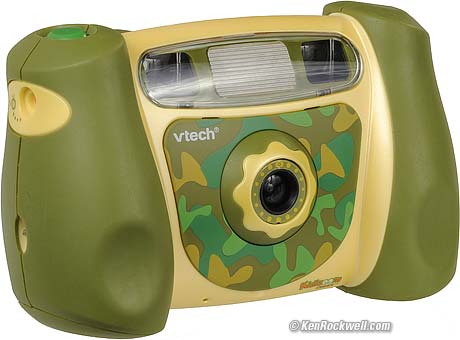Home Search Gallery How-To Books Links Workshops About Contact
April 2009
Updates RSS
all © 2009 KenRockwell.com. All rights
reserved.
|
I personally buy from Adorama, Amazon, Ritz, B&H, Calumet and J&R. I can't vouch for ads below.
|
30 April 2009, Thursday
Wein EPX-625: $4.50.
NEW: Wein EPX-625. A perfectly good replacement for EPX-625, PX-625 and PX-13 mercury batteries.
California's Volcano Country Tour
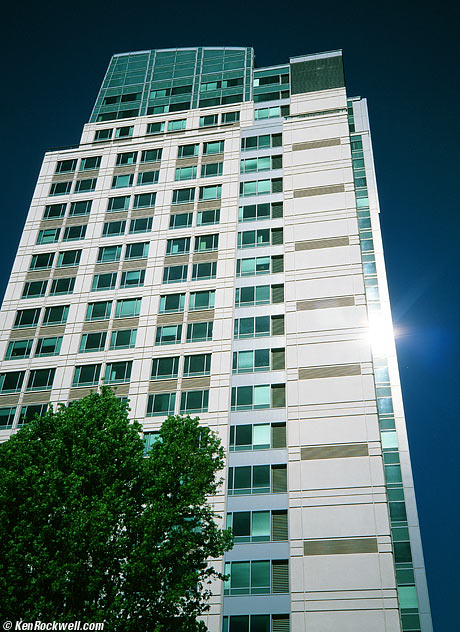
Yakashima Prefecture, Japan?
Is this a snap from a camera brochure touting some advanced light metering system?
No; it's a snap made on an Olympus 35RC from the parking lot of the downtown Sacramento, California Best Western as we loaded up the vans to head out on Dave Wyman's latest tour of California's Volcano Country. I just got my film back.
How did I meter with the sun reflecting off the building? Simple: I pointed the camera in a different direction, pressed the shutter halfway to lock the exposure, composed, and shot.
The film looks great, but darned if I know how to resample and sharpen an image in Photoshop without all these straight lines going jaggy. You ought to see the film!
27 April 2009, Monday
New Book Mention
I added Location Lighting Solutions by Jack Neubart to my Books list.
It shows many examples of fantastic lighting and how to create it. As I keep reiterating, lighting is by far the most, and often the only, important technical aspect of photography.
It's aimed at the full-time commercial photographer, not the casual amateur, but if you follow along and can duplicate what he shows in the examples (I haven't tried and can't vouch if the book explains it well or not), the results will put you ahead of all the other hacks competing for the same commercial jobs.
Which is the Best Camera?
While the Mamiya 7 is the world's best camera, the best camera is always the one you have with you.
Since some geeks still think cameras, not people, make pictures, I thought I'd show you the work shot exclusively on an iPhone by renowned pro Chase Jarvis.
If you can shoot well, all you need is a disposable, toy camera or a camera phone to create great work. If you're not talented, it doesn't matter if you buy a Nikon D3X or Leica; your work will still be uninspired.
It's always better to spend your time and money on learning art and composition, not by spending it on better cameras.
Until you can shoot as well as Chase, don't kid yourself into thinking that better cameras take better pictures.
Your camera never matters. A nicer camera may make it easier, faster or more comfortable to take pictures, but never improves the results unless it's a camera store, magazine or commercial website telling you so because they make money selling you more cameras.
Thanks, Chase!
25 April 2009, Saturday
Fire and Ice Tour
I'm back from a week shooting in north-eastern California.
I shot 13 full cards (rolls) of RealRaw, but only made 38 shots on a digital camera.
The only digital I brought was my Canon SD880, but I got tired of carrying it in my pocket. I left it in my luggage after the first day of the trip. I mean, why bother with carrying a digital camera when you hold the power of RealRaw right in your hands?
I brought an Olympus 35RC, a Leica M7 with 21mm f/2.8 ASPH, 35mm f/1.4 ASPH and 90mm f/2 APO ASPH lenses and several filters in 43.5mm, 46mm and 55mm. The Leica system sells new for one-thousand times what the 35RC is worth, and I'll bet you the results are pretty close.
The Leica feels much better in your hands than the dinky 35RC, but the Olympus feels better to carry around your neck all day, and it's more fun to shoot since the 35RC has a better metering pattern, more reliable ISO setting, a cleaner and more complete finder and a clearer and less ambiguous rangefinder spot than the M7. I'll have to do a tally later.
I carried all this on my neck and a Speed Demon bag.
While I was gone, the $35 neoprene Kata Ergo-Tech Format Q bag I ordered arrived. It's too small to carry the bloated Leica setup I took this past week, but might be able to swallow a real (39mm filter size) Leica setup. It certainly holds the Leica and new/used film just fine, and probably can hold an extra real Leica lens, like any of the 39mm filter-size lenses, too. I haven't figured out the divider system yet.
It can hold a Canon T90 and FD 50/1.8, or Contax G2 and reasonable lens, or Leica M7 and 35/1.4 ASPH. It can fit a D300 and 18-200mm VR or Canon New F1 and FD 85mm f/1.8 perfectly, but it's starting to get too heavy.
The Kata Ergo-Tech Format Q is deep top-to-bottom, but not very deep front-to-back.
We'll see, but if you want a small, comfy waist pack for a smaller camera, the Kata Ergo-Tech Format Q sure weighs less than the much larger Speed Demon and it's still in stock, unlike every other bag I mention here that gets sold out.
NEW: Camera Repairs. You break it, they fix it. These are the people to whom I've sent my broken cameras and lenses.
24 April 2009, Friday
OC Camera
I brought an old (1959) Leica lens into OC Camera, and just as they claimed, they do have a very good repair guy on-staff. My dog found it out in the yard.
Gus at OC Cameras was able to fix one problem (a gritty aperture ring that didn't click), but discovered after opening it that it had damage from a previously botched repair attempt.
Since it was too messed up to deserve a complete overhaul, I wound up getting the aperture ring problem fixed, and there was no charge.
The very cool part is discovering a repair place that knows old cameras, and that the work was done without technician tracks (cosmetic damage from tools).
Beware of Stupid
Popular media always tries to scare people, which gets people to read more.
All of us know, and we try to teach our parents, not to click on any links from any email we get from eBay, PayPal, Bank of America, or whoever.
We know those are all spam, and if anyone does click on any of those links and enters their login information on the web page that opens, that all their personal information has just been entered into a crime website that just happens to look like B of A or PayPal. We know that.
Likewise, all Mac users know never to enter their password into a box unless they are installing software they intend to install.
One of the many ways Macs are impervious to viruses is that nothing can install itself on your Mac unless you enter your password to give it permission. No password, no virus.
Windows computers die fast because viruses infect them just like they infect people: they install themselves without asking permission. Windows computers have so many holes that viruses install themselves without having to ask. That's among the reasons why windows computers are always dying.
Just like the weak attempt at a Mac attack last year that arrived as emails that claimed to be JPGs of Anna Kournikova naked, no one caught that virus because 1.) Macs just show JPGs in the email (no one has to click anything), which raised our eyebrows when we didn't just see naked pictures in the email automatically, and 2.) the rogue virus software that was actually an install package that had a title of ".JPG" still required users to enter their password for the virus to install. Even the most desperate Mac users know never to enter passwords to install software that they don't intend to install.
Today the media is trying to scare us, since as usual there are always stupid people. If you use bootleg software, possession of which is a crime in most places, duh, some bootleg ripoffs of some Apple software have some garbage in them.
Duh! Why do you think people write and distribute bootleg software? To take over your machine, bucko.
Thankfully very few Apple users have been stupid enough to use bootleg software, so the iBotnet Trojan horse (named after the USC teams) hasn't gotten anywhere.
Media is trying to scare people by calling it a virus, but its not. You can't catch it unless you install it. All the iBotnet Trojan horse is is crappy software designed to screw your machine if you're dumb enough to install it; not anything that you can catch unless you ask for it specifically.
Moral: Always use legitimate software, and never enter your Mac user's password if you aren't intending to install something, but you already knew that.
Mass Media
Two other points about mass media popped up this week as I was out shooting in far North-Eastern California:
1.) I was asked why magazines continue to accept ads from stores that the people asking me these questions knew were scams. For instance, the guy asking me was wondering why you still see adds from Broadway Photo in most magazines, while this guy has been screwed by them many years over.
As I keep reiterating, the answer is simple: much commercial media values advertising money over the best interests of their readers. If it pays, it plays, and let the readers figure it out. It took most magazines many decades to drop Cambridge, and I see they are popping back up again in print.
2.) We all heard that the USAF flew some live nuclear bombs cross country last year. So? That's what the USAF is supposed to do. That's not news, but it was reported as if it was. The real news that the media didn't bother to explain in detail was that the USAF thought it was flying practice (dummy) bombs, and accidentally was packing live nukes. Whoops!
That's news, but big deal: few Americans realize that not only has the USA dropped nuclear weapons on our enemies in the 1940s, that we even dropped them on ourselves in 1958! On 05 February 1958, we dropped a nuclear bomb on Georgia. My brothers read the history and claim it was on land and left a crater from the conventional high-explosive, but the Air Force now tells us it was dropped in the water.
No big deal, I wasn't around. I'm just trying to explain why I don't bother reading newspapers or listening to radio or TV news: the real news isn't in them. Heck, I felt like a moron when I discovered that Fidel Castro finally resigned - last year. That's news, but the news is too busy telling us what the stupider people want to learn, like the name of Brittany Spears' dog, than real news.
17 April 2009, Friday
Nikon D5000.
Continuing: Nikon D5000. I've annealed my analysis, and especially clarified my recommendations compared to the D40 and D90. I needed to add that I love the D40 since it does 99.9% of what I need, but that have a D3 for the other 0.1%.
If I only had one DSLR, it would be a D90 or maybe a D5000. The tradeoff is your preference for LCD, and if you use old AF lenses. I'd probably go for the D90, although if money mattered, the D5000 is most likely the winner.
I'll know in far more detail when I get a D5000 in my hot little hands; for now, it's a Canon SD880 riding shotgun in my pocket while I shoot Velvia in a Leica and a 35RC for laughs.
New: Adorama is taking orders for the new Nikon 10-24mm. This lens is such a no-brainer for anyone shooting DX who love wide angles as I do that, if you shoot DX, it's a must-have. I just ordered my own from Adorama. More Info from Nikon. Yes, I'll be adding a full review. It will be great if this Nikon lens can out-do the sub-optimal Tamron 10-24 and fast and spectacular Tokina 11-16mm. We'll see.
Updated: I freshened the links at the top of the page. Now you can get to many of the most popular reviews, or their indices, in one click.
16 April 2009, Thursday
Olympus 35RC.
NEW: Olympus 35RC Review. Photography's Holy Grail; I get 40 perfect shots on each roll with the 35RC.
Updates
I updated the Comparisons and Recommendations in my Nikon D5000 page.
13 April 2009, Tuesday
Chinon Auto2001 (1980s)
Sea•Life Aquarium, California. Shot with Chinon Auto2001 and expired, made-in-China, Kodak Gold 100 print film. enlarge.
The Chinon Auto2001 is a $3.50 point-and-shoot camera I picked up at a local thrift store. It works fine.
It's a basic, cheap 1980s autofocus fixed-lens point-and-shoot. The only shooting control is the flash switch.
I loaded some expired-in-2007 Chinese print film and had at it.
NCPS processed the film, and it looks fine. I posted another shot from it at Ryan's website for 08 April 2009.
Now maybe I'll try some Velvia, if I press my luck that its DX might read ISO 50, to get some real color.
Call me crazy, but this beater old point and shoot has its charms, like a far-faster wake-up time than a digital camera, and faster than other point-and-shoots since as soon as you slide open the barrier, it's ready to fire. Likewise, it has a perfect spring-loaded flash OFF - AUTO - FILL slide switch right by your thumb as you shoot.
Why can't good cameras be thought out as well as some crappy cameras? How come no other camera has as smart a sliding flash-mode switch as this $3.50 camera? This Chinon goes the instant you flip open the barrier; you never have to wait for a lens to motor out from its burrow, and it had 3 LEDs in the finder to let you know the autofocused distance.
Not bad for $3.50.
I still haven't picked up my 110 film, heh heh.
Want to see some really bad color?
Have a look at the shot made with Velvia under fluorescent light of a my kid Ryan (scroll down to April 5th). Even severe color correction in Photoshop couldn't save it.
It's nasty. That what happens when you use the wrong film for the wrong kind of subject under the wrong light with the wrong filter.
Shoot it wrong, and it's wrong. The only reason I published it was because the gesture, which is all that really matters, is great.
12 April 2009, Easter Sunday
It's Easter, Yay! Take lots of color pictures!
I think I was about 12 in 1974 when the Easter Bunny brought me a Vivitar 202 flash in my Easter basket.
The Easter Bunny still brings me Easter baskets: if you believe, you shall receive.
Sorry, no new reviews today: I can't wait to go downstairs and see what he brought us. Yay!
Easter is my favorite holiday. Not only is it the most important holiday in the Christian calendar, Easter is always chosen to have spectacular weather. Enjoy it and make basketfuls of great photos! Yay!
11 April 2009, Saturday
Think Tank Speed Demon, Nikon D300 and more.
NEW: Think Tank Speed Demon. A great waist bag.
10 April 2009, Friday
Photoshop CS4
I never thought I'd be able to find anything it did to make it worth my while, but whoa, CS4 is very valuable to me. Darn Adobe figured out how to put in a few more features that matter enough to make it worth it. Darn them!
Specifically, the Quick Select Tool is saving me a ton of time processing my product shots so that I can pull them off my studio background and drop them on 100% white, so they pop on my pages here. To me it's a big deal, but the Quick Select Tool came out in CS3, to which I never bothered to upgrade.
In CS4, the S (clone) and J (healing brush) tools now overlay what they're going to paint over my image as I touch-up dirt and defects. This also saves a lot of time, since I can fly over the image spotting it instead of having to obsess for four times as long in CS2, where I flew blind until after I clicked to lay down something.
How do I make my product shots look decent? Mostly by using good lighting, and then by spending hours cleaning up every speck of dust, every scratch, every fingerprint and every defect with the clone and healing brush tools so they look perfect blown up.
The new live previews of the clone and healing brush tools alone save me enough time to pay for CS4, but I bill at a high rate. If something saves me just a minute each day, I'll spend a thousand bucks for it. CS4 saves me a lot more time than that! (I bill at $500/hr, so 1 minute a day is 250 minutes, or over 4 hours, a year.)
Sure, Photoshop CS4 has a lot for the video game crowd like better panorama stitching and pan-focus compositing, but I don't do that.
We all use PS for different things. I'll be having a full review, but while I'm touching up shots for tomorrow's review of the Think Tank Speed Demon bag, I thought I'd let you know how handy CS4 has become. Yay, Adobe!
NEW: Canon FD Camera Comparision. No big deal, just a quick table I whipped up for myself.
Kodak Hawkeye Brownie: As Andre dos Santos explains, with a fixed focus, fixed shutter speed, fixed aperture and no tripod socket, he finds these limitations makes him forget about all the unimportant stuff and forces him to be creative. His shots look much better than most of what people show today.
09 April 2009, Thursday
Canon New F-1, 50/1.2L and AE Power Winder FN.
NEW: Canon AE Power Winder FN. A little out of context since I haven't reviewed its matching camera yet, this is a power winder for Canon's New F-1 from 1981.
I had to get one to activate the shutter-priority mode of the New F-1 I'm trying to review. I prefer to wind by thumb than carry another pound (450g) around my neck.
08 April 2009, Wedneday
Twin Lakes. Shot with a two-stop ND Grad.
NEW: Graduated Neutral-Density Filters. A basic tool-of-the-trade.
NEW: Lighting.
This is an article I should have written ten years ago.
Lighting is the most important technical factor in every photograph.
NEW: Straps. No big deal, but I never use the strap that comes with any camera.
07 April 2009, Tuesday
Go make some albums!
My wife is a lot smarter than I am.
I snap a lot of pictures, but rarely do anything with them.
Yesterday she asked and I burnt her a CD with 500 (original-sized) images from our kids' websites, she brings them to Price Club and has hundreds of 4x6" prints made of it all. It's easy: stick in the CD and hit GO.
She picks up three sets of photos an hour later, brings them home and slips them into the photo albums she got at Ross for cheap, and we now have fantastic, permanent baby albums to send the grandparents.
Unlike archival inkjet prints which aren't, these real Fuji Crystal Archive prints will outlive me.
My wife handed me an album last night with the images I had shot and posted earlier the same day on Katie's website!
This is what digital is all about: the fluid ability to do anything you want with your images.
Photography
Photography is a means of expression, just like writing or painting.
Because photography is a means of expression, you have to have something to say, or your photos will suck.
Blindly pointing a camera and then expecting to whip it up later in Photoshop always results in crap.
Buying a Nikon D3X, Leica M7 or Canon 1Ds Mk III and expecting it to make sharp photos doesn't happen. Sharp photos come from sharp minds expressing ideas clearly.
You don't need to be able to express whatever you're trying to say in words or any other form, so long as whatever you are trying to express comes out in your photos. Composition is key.
Photography is an art which, like most art forms, happens to use some technology, but photography still has nothing to do with technology
Because some technology is involved, there are always legions of unseeing people who just don't get it. If you're not an artist, it's easy to miss the whole point and spend a lifetime reading books (and websites like this) fretting the tech details and buying too much equipment, instead of learning how to recognize what makes good photos and doing it.
Once you know the basics of how to adjust the camera you already own, no amount of technical knowledge or more equipment is going to make your photos any better.
I know. I was an engineer and the first twenty-three years of my photography sucked for exactly this reason. I could tell you every aspect of lens design, or explain bicubic convolution, sub-pixel processing and JPG quantization matrices 20 years ago, but I still had no idea what made a good photo.
I didn't start making good photos until I started looking at what was in my photos, instead of looking for how sharp they were. You can see everything you need to see in a photo from arm's length, or even as a thumbnail.
I finally learned to pay attention to what I liked or disliked about each photo, and doing more of what made photos I liked, and less or what made photos I didn't.
Photography is nothing but applying your powers of observation. No tech knowledge is needed today; all you need to know technically is if you want your photo darker or lighter (use your Exposure Compensation control) or a different color (use your White Balance control).
You need to recognize what you want and in which way to turn which knob to get you there, but everything else is art: where you are, where you point the camera, and what you're seeing.
Cameras and lenses all do the same thing. Don't even start to worry about lens sharpness until you can make great photos with what you already have. If you can't make great photos with a disposable camera, you can't make great photos until you learn to see.
Worse, if you're still learning (I know I still am), the more complex cameras throw up more adjustments and menus in the way of seeing great photos You'll get worse photos with better gear!
This is always obvious when people send me technically decent, but completely uninspired photos. If they weren't stoked when they took it, and if they don't get off on it being a good photo, no one else will either.
A friend once told me about how sickening it was to judge a photo contest. Numerous entries sucked hard. There was nothing in the photos, yet people thought that if they cranked up the saturation and sharpening in Photoshop enough that maybe the computer would find something interesting in these photos.
Nope. All it does is make these photos hurt our eyes. I get wild colors by pointing cameras at colorful things, and I get sharp photos by looking for hard cross-lighting.
Too many people need to lay off the saturation button and lay hard on their camera's DELETE button. If it sucks, it sucks and it's not getting any better. Try a different angle, a different point of view, different lighting or anything, but try it while you're still out shooting and can do something about it.
Don't shoot like your teacher. It becomes all too obvious who is learning from whom, and who was the teacher and who was the student.
Learn how to express yourself from your teachers. Learn the two trivial-to-set but critical-to-making-great-pictures basics of how to set your exposure compensation and white balance, and you're done learning technique. Let your teachers show you to express yourself more strongly, but remember that the key word is to express yourself.
Never try to copy your teacher's, or anyone's photos. Only they do what they do best. No one can be them better than they already are. You can be better at being yourself better than anyone, so follow your own impetus when making your photos. Shoot what you want, how you want it, but make it your own. Never try to do anything to impress anyone other than yourself.
So what makes good photos?
Whatever turns you on. Shoot, look at your work, and keep doing more of what you like.
If it's good, you'll see it. If you don't see what you like, try other things until you do. The key is to keep trying different things, not improve on something you dislike.
I found that my favorite work is what I shoot as day turns into night, or back again.
I also discovered that even though I shoot everything, the shots I show are almost always shot with my widest lens. Now I'll often go out with just an utrawide lens, and leave the other junk locked up.
Don't do what you've seen others do. Only do what you want to do. Be yourself; not someone else.
Backpacks
Backpacks are awful. I keep wondering if I'm the only one who sees this, or if I'm crazy since I see every newcomer to photography trying to deal with one.
I was talking to another full-time travel pro, and he laughed in agreement when I asked him. We're both astounded at why so many otherwise intelligent people new to photography waste their time with backpacks.
You can't shoot out of a backpack. Leave it at home! Use the Two-Pocket Shuffle, a small bag, or the smallest bag into which you can get while you're moving.
All you need are a wide lens and a long lens. You can walk forward or back to frame anything else in between. Never try to carry more than one lens that covers any part of the same range!
Leave as much home as you can.
Losers
Losers give up.
Losers are people who set their standards so stupidly tight that nothing is good enough for them. These are not LEICA Men, who always get what they want. Losers are our friends and neighbors who set the wrong criteria for jobs, toys or lovers, and wind up with nothing instead of happiness.
I've heard too many stories of lonely girls staying single because they are so picky that they want a boyfriend in only a very narrow range of age, style or income, and too many people who stay unhappily unemployed for too long because they are completely unrealistic about wanting whatever overly bloated salary they used to pull down (all while wasting their boss' time reading the internet at work), or too picky about the hours, location, type of work or whatever.
People stay unhappy when they keep thinking they're going to find perfection.
Winners get what they want. Winners set realistic expectations, and are always open to new ideas for things that don't fit in their initial expectations. Winners never give up. Winners adapt and get better. The best jobs I've ever had were those for which I initially wasn't even going to bother to interview, but decided, eh, what the heck, and checked it out!
This applies exactly the same way in photography (I knew you were wondering).
Loser photographers set out with a preconceived notion of what they want to snap. If they find it, which they probably won't, they are happy.
All too often (like every single time), what they want just doesn't happen. They shoot a crappy version of what they thought they wanted, and try to jack it up later in Photoshop.
Winners in photography keep their eyes open. Photography is all about your powers of observation, period.
All my best snaps have been completely unrelated to what I thought I was going to photograph that day. I kept my eyes open, saw something cool, and snapped it. I created the photo because I kept my eyes open to new things, never because I set out to make that photo.
When everyone else is looking for the clichée in one direction, my screwy mind is off looking in some other direction trying to sniff out cool photos.
06 April 2009, Monday
Nikon 35mm f/1.8
I added a section on the survivability of the Nikon 35mm f/1.8.
Holy Cow — I Found a Real Camera Store!
For the first time I can recall, I found a real camera store outside of New York City. Sure, we have Samy's and Calumets all over California, but these guys are all the same: the same DSLRs and lenses for sale, and nothing that you can't get better, faster and cheaper over the Internet. Except for NYC, I haven't found any stores with interesting stuff that you won't find everywhere else.
On Saturday I wandered into another camera store out of curiosity. All it said in the window was "OC Camera," so I wandered in while the Mrs. circled the parking lot on the family's way to our next errand. I just wanted to see if it was anything other than another dull mall shop with a few DSLRs, some off-brand lenses and a thousand kinds of frames, digital keychains and imprinted coffee mugs.
The first thing I see right next to the door is a bunch of Hasselblads in a tall glass case.
Hmm, real cameras!
The next thing I see is a gold Hasselblad (again, curious), and next to it is a section for old Nikons. Not modern Nikon SLRs like the F2AS, but old Nikons: they had an SP from 1956 and a slew of lenses for the Nikon rangefinder mount.
OK, by now I've figured out that this is a local strip mall, but not a mall photo store.
Next I saw the Leicas. They had not only new Leicas, but old stuff going back at least to the 1950s. I was so busted, since this weekend I was shooting a 1955 Leica M3 and its original 1955 50mm f/2 lens that had just come back from overhaul at Sherry Krauter. This M3, as well as my 1980 MR-4 meter clipped on top, was what was hanging around my neck as we ran errands with the kids.
And they had Leica SLRs. And they had Nikon, Canon, Minolta and God knows what other kind of traditional SLRs. And they had film, and they had paper. What was in the case that most people who look straight ahead would have seen when they first walk in? A case full of Holgas.
What's a Holga? It's a camera favored by many of the world's top photojournalists. Last year a guy won a Pulitzer prize with a shot made on one, and what exotic camera is around the neck of the National Geographic photographer featured on page 4 of the February 2009 issue? A Holga, the secret behind many of the world's greatest photos.
I peeked in the back, and they had piles of view camera lenses.
I was only there for a few minutes, just to see if it was worth visiting again when I had more time, and holy guacamole, YES!
I'm sure they had DSLRs someplace, but the key thing I was muttering to myself was "wow, these guys have no crap. Everything here is something worth having!"
I didn't have the time to check it all out, but I did find a manual to the power winder I just bought to fit on an old Canon New F-1 I got to review. It turns out the old New F-1 won't work in shutter-priority mode unless you buy the Canon motor drive or winder, a trick Canon pulled to sell more winders. Great; so I have to bolt-on another pound of crap just to get Tv mode? I'm sure I'll figure out some way to jumper around this one.
In case you're in Orange County, California, check these guys out in person at:
OC Camera
27680 B Marguerite Parkway (use Crown Valley exit from I-5)
Mission Viejo CA 92692
(949) 347-1276
Hours: 10 - 6 Pacific Time, Monday - Saturday.
They are they guys to check if you're looking for weird gear for serious shooting. No, its not cheap, but what they sell isn't what you'll be replacing in two years like a DSLR.
Which brings me back to clarifying the digital vs. RealRaw issue.
For photos of action, news, sports, people, low-light, kids and just about everything for just about everyone, DSLRs are the way to go. The images are faster, easier, and cleaner than what you can get in RealRaw, with a lot less effort and demanding far less skill. In the middle of writing this blurt, I stopped, shot a bunch of snaps of my baby girl Katie with my D40 and 35mm f/1.8 AF-S and posted them, and got back to writing this. Digital is fast, clean and easy. That's why everyone shoots it.
Most of my serious work doesn't fall under the above categories. My serious work, what I'd hang on exhibit or on my walls, is printed man-sized on Super-Gloss and lit with about three lights, is quite different from what shoots well on digital. For contemplative work, I prefer film. I'm a weirdo, but film is where it's at for serious work, and film gear seems to be what's all over OC Camera.
05 April 2009, Sunday
Canon T90
I fired up my Canon T90 yesterday for the 1st time. Wow, what a great manual-focus camera! Thanks Larry!
It includes a spot-meter with the best Zone-System implementation I've ever seen, far better than the spot meter Ansel Adams used (the Pentax Spotmeter V and then the Pentax Digital Spotmeter).
In the T90, you press the Spot button while pointing it at the highlight and then press again in the shadow, and it magically places each value for you. Now as you cruise the scene with the spot meter, you can see where each value falls.
To change your zone placements (exposure) just press the dedicated zone placement buttons with your thumb and the whole system shifts up and down while you watch everything on the ±4 stop bar graph. Brilliant!
Oh yes — you can do all this Zone-System work without taking your eye from the finder, heh heh.
You can do sort of the same thing with the Nikon spot meter in most Nikons, but it's not as easy or elegant, and Nikon meters don't have the eight-stop in-finder display range of the Canon T90.
The Canon T90 works only with the orphaned Canon FD manual focus system, and only in RealRaw. That's great news, because the best things about the Canon FD system are the fantastic 50mm f/1.2 FD L and 85mm f/1.2 FD L lenses that you can get used for cheap; less than a new Nikon 50mm f/1.4 precisely because it's an orphan system. Whoo hoo!
I suspect the Canon 50/1.2L FD, which only cost me $350 over Nikon's 58mm f/1.2 NOCT-Nikkor, which sells for ten times the price. Both the Nikon 58/1.2 NOCT and the Canon 50/1.2 L are aspheric, but only the Canon uses floating elements for perfect correction at every focus distance.
I've tested (but not yet reported on) the Canon 50/1.2L FD, and its performance is incredible, even at f/1.2.
Likewise, the Canon 85mm f/1.2L FD is another incredibly fantastic performer I picked up used for a few hundred dollars, and Nikon has never made anything close. Nikon's 85mm f/1.4 AI-S lens is one of the best lenses Nikon has ever made (superior to today's 85mm f/1.4D AF), but Nikon has never made any 85mm that comes anywhere close to the performance of the Canon 85mm f/1.2 L lenses, which use aspheric elements.
I just got my hands on another gem, the Canon 24mm f/1.4 L FD, which is very hard to find but still sells for a lot less than anything similar. Nikon has never made anything like this in 24mm, although Nikon's 28mm f/1.4D is similar. The gotcha is Nikon's 28/1.4 will set you back five times what Canon's 24/1.4 will.
I've also got a line on a Canon 14mm f/2.8L FD, which has the unexpected advantage of being the smallest 14mm ultra-ultrawide lens I've ever seen.
Screw the FD L long telephotos most people associate with Canon L lenses. The best photographs come from getting close enough not to need crazy-long lenses. The real gems of the Canon system are the L lenses in the focal lengths that matter.
For you modern Canon shooters, Canon is on their third generation of all of these lenses for EOS and digital cameras: the 14/2.8 L II, 24/1.4L II, 50/1.2 L II, and 85/1.2 L II. Nikon hasn't even gotten off the ground on any of these, ever, except for the Nikon 14/2.8D and 28mm f/1.4D, while Canon's current dash-II offerings are their third versions of each of these! The gotcha with Canon's EOS and digital SLRs is that their AF systems aren't as consistent as Nikon's, so depending on your choice of body, your shots may not always be in focus with these fast lenses — whoops!
Of course I'll have to let you know what sort of focus accuracy I get with the T90 at f/1.2; the T90 film is still at the lab. I shot the lens tests to which I referred above on a Canon T70 last year, and gave up when I couldn't get precise focus anywhere other than infinity.
The T90 may have a great implementation of the Zone System, but it has no Matrix Meter as did the Nikon FA that came before it. Nikon's Matrix Meter made multi-spot metering a thing of the past.
Yes, I'll be reporting on all this as soon as I can, just like everything else.
D90 PDF Guide
I expect the PDF of the D90 User's Guide any day now. I had to hire someone to convert it; PDF is beyond me.
Photoshop CS4
I just installed my copy, and also Dreamweaver CS4.
The bad news is that Photoshop isn't smart enough to copy my preferences, actions, filters, keyboard shortcuts and plugins from the CS2 version I've been using all day, every day since 2006.
This is why I've waited so long to upgrade: it's too much work to get a new version of PS to work the way I was working. Apparently Adobe isn't as smart as Apple when it comes to updates.It may take a week before I'm up and moved-back in to PS CS4.
Don't try to get me to believe that Adobe isn't smart enough to figure this out if they wanted to. Adobe's registration and authentication system works great and seamlessly. Did you know that, ever since I think it's version CS, that if you try to open an image of US paper money or stamps, that not only will it not let you open the image, that your name, address and other personal information are sent directly to the US Department of the Treasury for potential investigation? Adobe has your personal information from when you registered your copy of Photoshop to activate it.
If Adobe is this smart (the fact that it recognizes forbidden images so well is key), then why don't my actions and preferences just transfer? Heck, when I buy a new Apple computer, one firewire cable and a mouse click are all I need for it to take everything: programs, mail, etc., and transfer them all to the new computer.
The only reason I'm upgrading is to report on it for you folks; personally, CS2 does everything I need and a lot more. Heck, every version of PS since Photoshop 5.5 has been fine.
Dreamweaver CS4
I create this site on Dreamweaver 8, and hopefully Dreamweaver CS4 lets me make long pages well. It does; the redraw problem has been fixed, yay!
More good news is it found my sites and my server info, so it unlike Photoshop, it was a no-brainer to start working in my new copy of Dreamweaver CS4. Once I installed it, which was a pain, I fired it up and it was ready to go. Yay!
Now that I have it fired up, did I get a bad copy, or does Dreamweaver CS4 just plain suck?
My copy shows text in Design View worse than DW8, since the kerning looks crappy like it did back in Dreamweaver MX.
When I hit redraw (F5), half the screen is screwed up, and the worst thing is that the windows don't work right: when you're working in a window, it doesn't come to the top of the other windows (half might be hidden behind another window), and as you drag it, it won't snap in place.
Am I imagining this, or has anyone else seen really screwy performance in DW CS4?
I can't find the font size box in the properties inspector in DW CS4, so you're stuck with the ransome-note style above, since I can't find the places to fix this! I can't find the spell checker either, sorry. I'm sure I will, with time.
02 April 2009, Thursday
Leica 90mm f/2.8 Tele-Elmarit-M.
NEW: Leica 90mm f/2.8 Tele-Elmarit-M Review. Leica's purest long lens.
01 April 2009, Wednesday
NEW: Oskar Barnack. The inventor of the Leica.
New: The Kodachrome Project, chronicling Kodachrome's 75th anniversary.
New: My pal, humanitarian photojournalist Karl Grobl, just got back from 2-1/2 months shooting all over Cambodia, Thailand, Laos, The Philippines, Bali, Malaysia and East TImor. Karl is the guy we all have to blame for me starting this site; he had his website up long before mine and suggested I do my own back in 1999.
He's a huge proponent of pro gear because he shoots in real places, not the vacation "every day is like the first day of Spring" wonderland that is San Diego where it only rains at night, if at all. Karl's gear gets drenched in the rain in Southeast Asia, and he doesn't put his gear away when the downpours start. He's very happy he shoots his (now-naked chrome from paint wear) old Canon 1D mark somethings instead of cheaper bodies, since he doubts lesser bodies would keep going when dripping wet.
Want to know how he caries his gear? Read his review of his Think Tank belt system. Karl is one of the guys who turned me on to the Think Tank stuff, although I try to carry a lot less stuff than he does.
Trip to Peru: Karl and another friend, Jim Cline, are leading a trip to Peru May 20- 30, and they just had a cancellation if anyone else would like to go.
VTech Kidizoom.
NEW: VTech Kidizoom Review. No, not quite as sharp as a Leica film camera or even a Nikon D40, but a whole lot more fun!
Some of the crankier readers were whining about the lack of digital reviews, so here you go.
This is a real review. I haven't thought up an April Fools' yet.
I also bought a Disney Princess camera on close-out yesterday at Wal-Mart for $6.00, including battery and film. I hope I can make some killer images on it to send the digital snobs back to their computers.
What Was New in:
The end of September, 2008 (Photokina)
The beginning of September, 2008
December 2007: Loads of details about the Nikon D3, D300, 14-24mm and 24-70mm, much of which still isn't on the individual review pages.
November 2007: First hands-on details about the Nikon D3, D300, 14-24mm and 24-70mm, much of which still isn't on the individual review pages.
August 2007 (Loads of new Nikons and Canons)
2006 November - December (includes birth of Ryan Rockwell)
2006 October - November (includes photos from a trip to NY)
Home Search Gallery How-To Books Links Workshops About Contact




